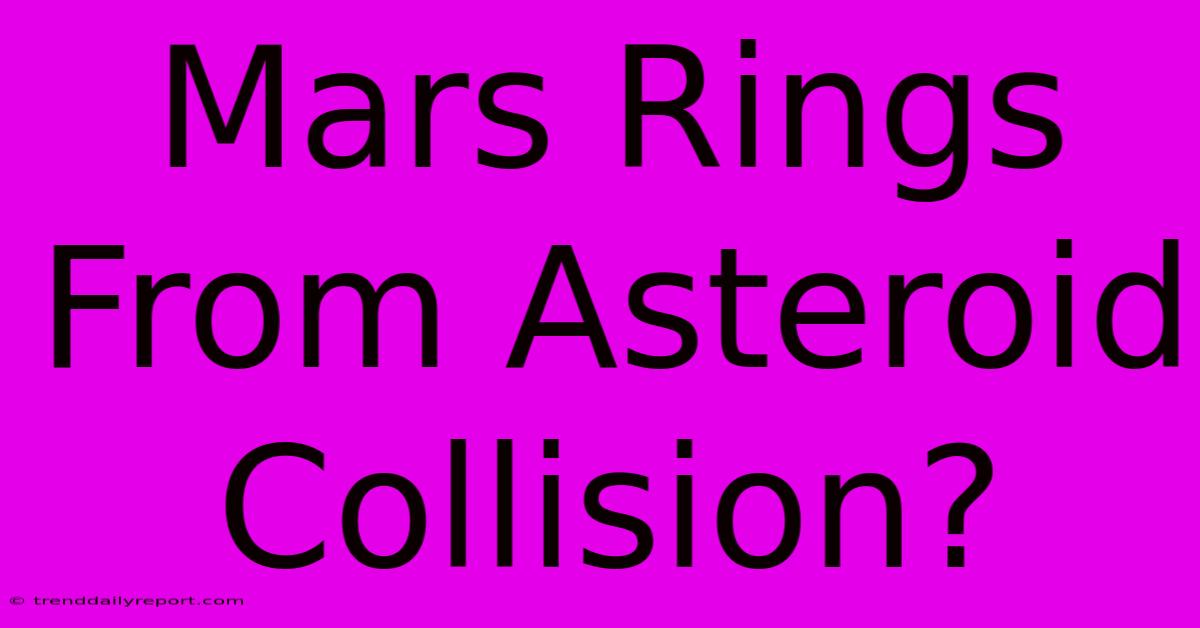Mars Rings From Asteroid Collision?

Discover more detailed and exciting information on our website. Click the link below to start your adventure: Visit Best Website Mars Rings From Asteroid Collision?. Don't miss out!
Table of Contents
Mars Rings: Could an Asteroid Collision Be the Culprit?
Hey everyone, so I've been totally geeking out lately about Mars. Specifically, the possibility of Mars having rings. I mean, Saturn's rings are iconic, right? But what if Mars had its own, albeit maybe less flashy, ring system? That's what I've been digging into, and it's way more interesting than you might think.
I'll admit, I initially thought this whole "Mars rings" thing was just some wild sci-fi speculation. I was picturing some crazy artist's rendering, not actual scientific theory. Boy, was I wrong!
The Phobos Mystery: A Ticking Time Bomb?
Turns out, there's a strong theory floating around that connects Mars's moon, Phobos, to the potential formation of rings. See, Phobos is slowly spiraling inwards towards Mars. It's losing altitude, like, a couple of centimeters every hundred years. This isn't some gradual drift; it's a countdown.
And this is where things get interesting. Scientists predict that within the next 20 to 40 million years, Phobos will either crash into Mars or... break apart. This is where the asteroid collision part comes in.
If Phobos breaks apart before hitting the planet, its debris could form a ring system around Mars! This isn't just some random guess; there are actual simulations and models that support this.
Remember, I'm not a scientist, just an enthusiastic amateur. But based on my research, I can definitely say that the possibility is there.
What Would Martian Rings Look Like?
Imagine this: Instead of the bright, icy rings of Saturn, Martian rings might be much fainter and dustier. This is because Phobos is a rocky moon, not an icy one. We're talking about a much more subtle display. The rings wouldn't be as visually striking, and honestly might be difficult to even spot with the naked eye from Earth. But they'd totally be there, adding another layer of complexity to the red planet's landscape.
The ring system's lifespan would be relatively short, geologically speaking. Eventually, the dust and debris would either fall into Mars's atmosphere or be swept away by solar winds. But the formation itself would be a spectacular event – the kind of thing planetary scientists dream of observing.
Past Asteroid Impacts: Clues to the Future?
This ties into the broader topic of asteroid impacts and their role in shaping planetary systems. Think about it: asteroid collisions are a major driving force in the evolution of planets and their moons. They're not just random events; they're key processes that have shaped the solar system as we know it.
While we don't have direct evidence of Martian rings right now, the possibility of them forming in the future is a very real one. Studying Phobos's orbit and composition is crucial, as this data provides valuable insights into its destiny and the potential creation of a ring system around Mars.
So, What Can We Learn From All This?
Even if we don't see Martian rings in our lifetime, the possibility itself is fascinating. The study of Phobos and the potential formation of Martian rings highlight the dynamic nature of our solar system. It emphasizes how planetary systems constantly evolve and change through processes like asteroid impacts and orbital decay.
Beyond the science, it reminds us to look beyond the obvious. Sometimes, the most exciting discoveries are hiding in plain sight, or, in this case, potentially hiding behind a dusty, faint ring system. That's what keeps me hooked on this stuff! Stay curious, everyone!

Thank you for visiting our website wich cover about Mars Rings From Asteroid Collision?. We hope the information provided has been useful to you. Feel free to contact us if you have any questions or need further assistance. See you next time and dont miss to bookmark.
Featured Posts
-
Champions League Barcelona Vs Brest Lineup
Nov 27, 2024
-
Bayern Boss Praises Psgs Quality
Nov 27, 2024
-
Vanderpump Rules Season Renewal Confirmed
Nov 27, 2024
-
Brits Get Extra Bank Holiday 2025
Nov 27, 2024
-
Fatal Crash Guilty Plea On Driving
Nov 27, 2024
